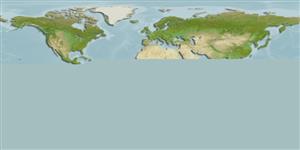Common names from other countries
Environment: milieu / climate zone / depth range / distribution range
Οικολογία
Θαλασσινό(ά); εύρος βάθους 0 - 50 m (Ref. 189). Tropical; 2°S - 20°S, 174°E - 171°W (Ref. 189)
Central Pacific: Fiji and Samoa.
Μέγεθος / Βάρος / Age
Maturity: Lm ? range ? - ? cm
Max length : 7.5 cm SL αρσενικό/απροσδιόριστο; (Ref. 128118)
This species is distinguished by the following characters: gill rakers on first gill arch, upper series 20-24 (modally 21), lower series 27-30 (29), total 48-53 (50); gill rakers on second gill arch upper series 14-17 (15), lower series 25-30 (26), total 40-47 (41); gill rakers on third gill arch, upper series 11-13 (12), lower series 13-16 (15), total 24-29 (26); gill rakers on fourth gill arch, upper series 8-10 (8), lower series 10-13 (12), total 19-22 (20); prepelvic scutes 2-5 (4); upper jaw long, its posterior tip slightly short of or just reaching to posterior border of preopercle; predorsal scutes absent; pelvic scute no spine; posterior border of preopercle convex, rounded; parietal and occipital regions with obscure paired dark patches, without following dark lines; no black spots below eye and lower-jaw tip; body relatively elongate, its depth 17.0-20.0% of SL (mean 18.7%); anal-fn base long, its length 20.2-23.3% of SL (21.2%); caudal peduncle relatively short, its length 14.4-18.3% of SL (16.4%); posterior tip of pelvic fin reaching to the second–fifth dorsal-fin ray origin (Ref. 128118).
A schooling species in shallow coastal waters. Used as bait in the tuna fishery in the South Pacific, although rare in bait catches in Fiji and Samoa.
Life cycle and mating behavior
Maturities | Αναπαραγωγή | Spawnings | Egg(s) | Fecundities | Προνύμφες
Hata, H. and H. Motomura, 2018. Stolephorus insignus, a new anchovy from the western Pacifc, and redescription of Stolephorus apiensis (Jordan and Seale 1906) (Clupeiformes: Engraulidae). Ichthyol. Res.1-9. (Ref. 128118)
IUCN Red List Status (Ref. 130435)
CITES (Ref. 128078)
Not Evaluated
Threat to humans
Harmless
Human uses
αλιεία: Εμπορικό(ά); δόλωμα: usually
Εργαλεία
Special reports
Download XML
Διαδικτυακές πηγές
Estimates based on models
Preferred temperature (Ref.
115969): 27 - 27.7, mean 27.2 (based on 8 cells).
Phylogenetic diversity index (Ref.
82804): PD
50 = 0.5000 [Uniqueness, from 0.5 = low to 2.0 = high].
Bayesian length-weight: a=0.00562 (0.00259 - 0.01222), b=3.18 (3.00 - 3.36), in cm Total Length, based on LWR estimates for this (Sub)family-body shape (Ref.
93245).
Τροφικό Επίπεδο (Ref.
69278): 3.3 ±0.4 se; based on size and trophs of closest relatives
Ελαστικότητα (Ref.
120179): Υψηλό, ελάχιστος χρόνος για διπλασιασμό πληθυσμού < 15 μήνες (Preliminary K or Fecundity.).
Fishing Vulnerability (Ref.
59153): Low vulnerability (10 of 100).
